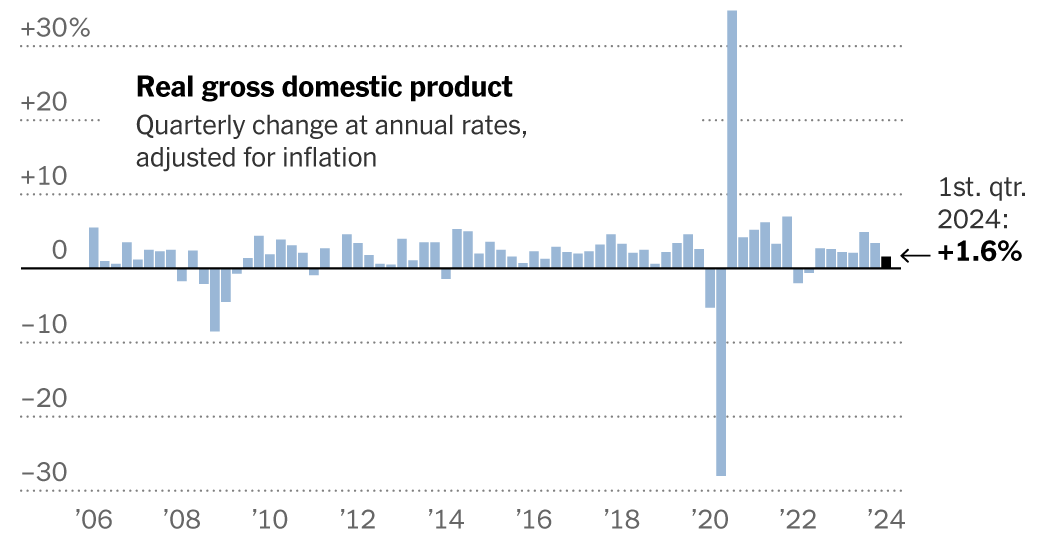April 27, 2024 | by Kaju

The U.S. economic system remained resilient early this 12 months, with a powerful job market fueling strong client spending. The difficulty is that inflation was resilient, too.
Gross home product, adjusted for inflation, elevated at a 1.6 p.c annual charge within the first three months of the 12 months, the Commerce Division said on Thursday. That was down sharply from the three.4 p.c progress charge on the finish of 2023 and fell effectively wanting forecasters’ expectations.
Economists have been largely unconcerned by the slowdown, which stemmed largely from large shifts in enterprise inventories and worldwide commerce, elements that always swing wildly from one quarter to the following. Measures of underlying demand have been considerably stronger, providing no trace of the recession that forecasters spent a lot of final 12 months warning was on the best way.
“It might counsel some moderation in progress however nonetheless a stable economic system,” stated Michael Gapen, chief U.S. economist at Financial institution of America. He stated the report contained “few indicators of weak spot total.”
However the stable progress figures have been accompanied by an unexpectedly speedy acceleration in inflation. Shopper costs rose at a 3.4 p.c annual charge within the first quarter, up from 1.8 p.c within the remaining quarter of final 12 months. Excluding the risky meals and vitality classes, costs rose at a 3.7 p.c annual charge.
Taken collectively, the first-quarter knowledge was the newest proof that the Federal Reserve’s efforts to tame inflation have stalled — and that the celebration in monetary markets over an obvious “delicate touchdown” or mild slowdown for the economic system had been untimely.
“It will increase the possibilities of a tougher touchdown,” stated Constance L. Hunter, an economist at MacroPolicy Views, a forecasting agency. “The inflation knowledge was the shock.”
At a minimal, cussed inflation is more likely to imply that the Fed will wait no less than till fall to start slicing rates of interest. Some forecasters suppose it’s potential that policymakers gained’t simply maintain charges “greater for longer,” as buyers have been anticipating for a number of weeks now, however may truly elevate them additional.
“It’s a large shift as a result of unexpectedly ‘greater for longer’ might imply one other hike,” stated Diane Swonk, chief economist at KPMG. For now, she stated, the Fed is caught in “financial coverage purgatory.”
Monetary markets fell on the information. The S&P 500 index ended the day down about half a share level, and yields on authorities bonds rose as buyers anticipated that borrowing prices will stay excessive.
Buyers aren’t the one ones who might undergo if rates of interest stay excessive. There are mounting indicators that prime borrowing prices are weighing on Individuals’ monetary well-being. Customers saved simply 3.6 p.c of their after-tax revenue within the first quarter, down from 4 p.c on the finish of final 12 months and greater than 5 p.c earlier than the pandemic.
The indicators of pressure are notably acute for lower-income households. They’ve more and more turned to bank cards to afford their spending, and with rates of interest excessive, extra of them are falling behind on their funds.
“There’s a sense that lower-end households are more and more stretched proper now,” stated Andrew Husby, senior U.S. economist at BNP Paribas.
But regardless of these strains, client spending, within the combination, reveals little signal of cooling down. Spending rose at a 2.5 p.c annual charge within the first quarter, solely modestly slower than in late 2023, and spending on providers like journey and leisure truly accelerated.
Spending has been pushed notably by wealthier customers, whose low debt and fixed-rate mortgages have insulated them from the results of upper rates of interest, and who’ve benefited from a inventory market that was till lately setting information.
“Greater revenue households really feel very flush,” stated Brian Rose, senior economist at UBS. “They’ve seen such an enormous run-up within the worth of their home and the worth of their portfolios that they really feel like they will maintain spending.”
That presents a conundrum for the policymakers on the Fed: Their most important instrument for combating inflation, excessive charges, is doing little to tamp down spending by the rich whereas hurting poorer households. And but in the event that they lower these charges, inflation might speed up once more.
Even so, forecasters stated the general financial image stays surprisingly rosy, particularly when put next with the glum predictions of a 12 months in the past. Unemployment has remained low, job progress has stayed robust and wages have continued to rise, all of which helped after-tax revenue to outpace inflation within the first quarter.
Companies stepped up their funding in tools and software program within the first quarter, a vote of confidence within the economic system. The housing market additionally rebounded, though that was due partly to a dip in mortgage charges that has since reversed.
Even one of many drags on progress within the first quarter — a swelling commerce deficit — largely mirrored demand from the US. Imports rose as Individuals purchased extra items from abroad, whereas exports rose extra modestly.
RELATED POSTS
View all


